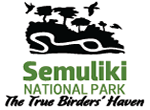[vc_row][vc_column width=”2/3″][vc_column_text]Birding tour Semuliki National Park is undoubtedly one of the amazing experiences not to be missed in 2022. Located in the remote side of Western Uganda, Semuliki National Park is with no doubt a strong hold of most interesting bird species especially the Albertine Rift endemic species. Over 441 bird species make Semuliki NP, Uganda safari park a true birder’s paradise and they range in its vast rain-forest and other habitats.
Spanning on 220sq.kms of land area, Semuliki NP is a home to almost 40% of the bird species in Uganda and about 66% of the forest birds that the Pearl of Africa boasts of. The Park’s birds include over 46 Guinea-Congo biome avifaunal species that thrive only in this particular part of East Africa and 35 of them exist in not more than 3 other sites in Uganda.
Birds of Semuliki NP, Uganda
Semuliki National Park supports one of the highest concentrations of avifauna in East Africa. Current records indicate 441 confirmed bird species, including 35 species restricted to the Guinea-Congo biome.
This assemblage places the park within Uganda’s list of Important Bird Areas (IBAs), designated by BirdLife International.
The birds of Semuliki National Park, Uganda include the Nkulengu rail, red rumped tinker bird, shoebill stork, yellow throated nicator, crested malimbe, lyre tailed honeyguide, Sassi’s olive greenbul, Congo serpent eagle, swamp palm bulbul, Maxwell’s black weaver, piping hornbill, white crested hornbill African piculet, blue billed malimbe, orange cheeked waxbill, yellow throated cuckoo, leaf love, the ross’s turacos, red billed dwarf hornbill, the great blue turacos, red eyed puff back, red billed helmet shrike, black winged starling, long tailed hawk, black casqued wattled hornbill.
Other birds that make Semuliki NP one of Africa’s top birding spots include lemon bellied crombec, Ituri batis, fire crested alethe, double toothed barbet, white tailed robin chat, mountain greenbul, spotted greenbul, bates’s nightjar, Cassin’s spine tail, swamp nightjar, blue swallow, western bronze napped pigeon, forest francolins, red-thighed sparrow hawk, Gabon woodpecker, kingfishers, red sided broadbill and more.
The park’s birdlife represents a biological extension of Central African ecosystems. Semuliki is the only site in East Africa where several Congo–Ituri lowland forest species are consistently recorded. These include Nkulengu Rail (Himantornis haematopus), Long-tailed Hawk (Urotriorchis macrourus), and Congo Serpent Eagle (Dryotriorchis spectabilis).
Birding activity concentrates along the Kirumia Trail, a 13-kilometer path running from the main gate to the Semuliki River. This trail crosses wetland margins, mixed forest stands, and open glades. It provides optimal conditions for spotting canopy, midstorey, and ground-dwelling species. Notable sightings include the Yellow-throated Nicator (Nicator vireo), Black-wattled Hornbill (Bycanistes subcylindricus), and Red-billed Dwarf Hornbill (Lophoceros camurus).
Besides Kirumia, birders frequently use the Sempaya Trail near the hot springs. Though shorter, this route yields high observation value. Species such as White-crested Hornbill (Tropicanus albocristatus) and Piping Hornbill (Bycanistes fistulator) are often seen in pairs or small groups above palm clusters. Occasional flyovers by Hartlaub’s Duck (Pteronetta hartlaubii) have been recorded during early mornings.
The park also records forest-edge and riverine species. The Red-rumped Tinkerbird (Pogoniulus atroflavus), Maxwell’s Black Weaver (Ploceus albinucha), and Blue-billed Malimbe (Malimbus nitens) favour transitional zones between intact forest and secondary growth. These are best accessed along the Red Monkey Trail or near the Semuliki River basin.
Rare sightings are documented irregularly. The Capuchin Babbler (Turdoides atripennis) and Yellow-throated Cuckoo (Chrysococcyx flavigularis) appear under particular canopy conditions. Local guides working with long-term researchers may assist in locating such species, especially between February and May when forest fruiting peaks.
Birdwatching is most productive between 06:30 and 11:00 hours. Light levels drop significantly after 15:00 hours due to dense canopy and frequent afternoon rainfall. Visitors are advised to carry high-sensitivity binoculars, rain covers, and insect repellent. Bird calls are a key identification tool; professional birders often use playback devices. These require prior approval from UWA Rangers.
Semuliki’s avian profile is valuable for comparative habitat studies. The species overlap with DRC’s Ituri region provides useful baselines for tracking biome shifts, particularly under climatic or anthropogenic pressure. The park’s record system is maintained jointly by Uganda Wildlife Authority and the Uganda Bird Guides Club. Serious observers are encouraged to submit their lists to the Avian Biodiversity Database (ABD) upon exit.
Best time to go Birding in Semuliki NP, Uganda
Birding tours in Semuliki NP can be done at any time of the year. In general, the best months to go birding are early June to September when the park experiences low or no rains. If your interest is spotting migratory birds November to April are the best months of the year to consider visiting Semuliki National Park for birding tour.
What to pack for Semuliki birding trip?
The essentials for your birding tour in Semuliki NP include field guide book, good walking/hiking boots, insect repellents, a bottled water, pair of binoculars, optics, a fully charged camera, safari hat, daypack, comfortable clothing and more.[/vc_column_text][/vc_column][vc_column width=”1/3″][vc_widget_sidebar sidebar_id=”shop-widget”][/vc_column][/vc_row]
